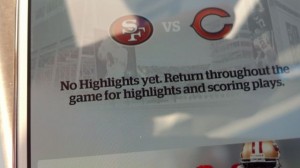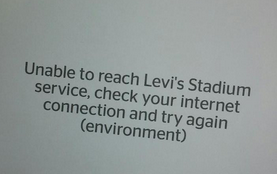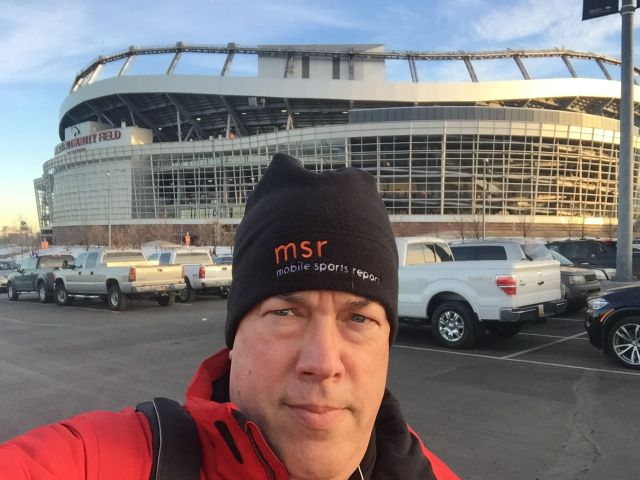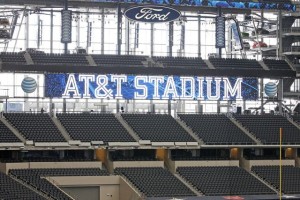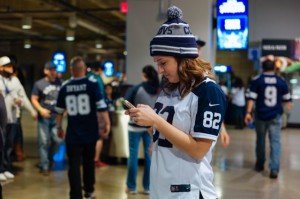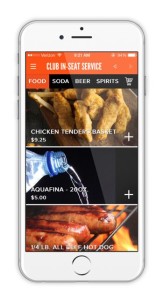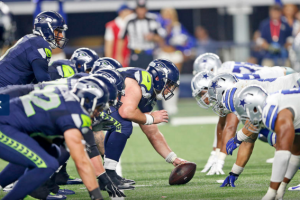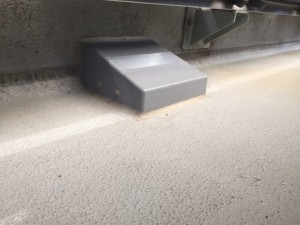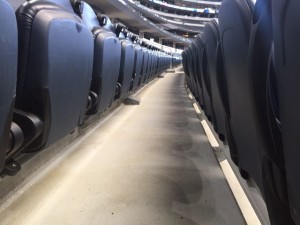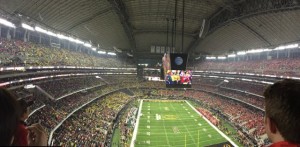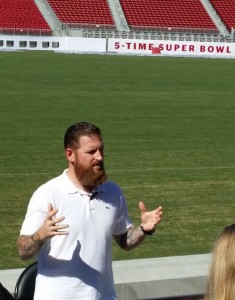
Dan Williams talks Wi-Fi while the Levi’s Stadium new turf grows silently behind him in this 2014 photo. All photos: Paul Kapustka, MSR
From our standpoint, Williams deserves credit not just for leading the deployment of a stadium network that set the standard for the future of connected venues, but also for being among the first to openly talk about the network’s performance, sharing statistics both good and bad during his short stay at Levi’s Stadium. His honesty helped open the door wider on a potentially rich stream of information that we think could greatly assist stadium network professionals everywhere, especially if more teams followed his lead and shared stats openly and honestly.
But the pursuit of meaningful network statistics remains a challenging process on many levels, and it’s one that is ironically likely to get more confusing today as multiple parties are set to release live network statistics from Super Bowl 50 at Levi’s Stadium. Both Verizon Wireless and AT&T are planning to release live game-day performance figures for their cellular networks in and around the venue today, and we also expect to get Wi-Fi network statistics from the San Francisco 49ers, if not during the game then shortly thereafter.
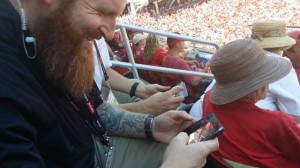
Niners VP of technology Dan Williams attempts to fix my Droid 4 Wi-Fi issues (while trying not to laugh at the fact that I actually have and use a Droid 4) during the first preseason game at Levi’s Stadium, July 2014
Out of school behavior provides the most interesting info
Like many other stadium network professionals we’ve been fortunate enough to meet and spend time with — a list here that includes folks like the San Francisco Giant’s Bill Schlough, Madison Square Garden’s Katee Panter, the Dallas Cowboys’ John Winborn, and Chip Foley, formerly with the Barclays Center, among many others — Williams from the start showed a passion for making the network better, so it could better serve the fans who used it. Our first face to face meeting came during the first preseason football game at Levi’s Stadium, when I tweeted that I was having problems connecting to the Wi-Fi network. William’s response? An email asking me where I was sitting, followed quickly by an in-person visit. Now that’s customer support.
The outcome of that interaction was a revelation that the Levi’s Stadium Wi-Fi network hadn’t prepared adequately for older devices that were still using the 2.4 GHz unlicensed bands; what was cool to me was not just that I kind-of discovered it by accident, but that Williams and his team admitted it publicly, then went about fixing it. The combination of objective reporting and honest confirmation, I think, worked to the benefit of all. But not everybody sees such things in the same light.
For instance, during the rest of Levi’s Stadium’s first year of operation, Williams shared with us not just raw “tonnage” numbers of Wi-Fi use but also interesting stats from the app, like exact numbers of replays watched and in-seat food delivery orders. Since those numbers were kind of low — in the low thousands for food deliveries and a decline in replay use after the season opener — they weren’t necessarily flattering to the owners of the system, even if you took into account the fact that some of this (like delivering to any seat in a 68,500-seat stadium) had never been tried before. In the end, even Niners CEO Jed York admitted that some elements of the stadium hadn’t performed as expected, as the stats we’d been seeing had borne out.After Williams left the team, the Niners took control of the network stats reporting and hugely trimmed down the list of things they were willing to report, though we would also note that Roger Hacker and the Niners communications team are still at the top of the list when it comes to consistent, repeated reporting of the network stats they feel comfortable talking about. When there are big numbers to report, all goes well because everyone loves to talk about systems that deliver for fans as promised. But I can also tell you that when things go south, so does a lot of the honest communication, an unfortunate if understandable situation.
Who will tell you when things don’t work?
For Levi’s Stadium, the darkest night for the network came on Feb. 21, 2015, at the NHL’s Coors Light Stadium Series outdoor hockey game between the San Jose Sharks and the Los Angeles Kings. In what has easily been our highest-traffic post ever, we described in detail some of the big problems that surfaced that evening, which included breakdowns of the delivery service, the Wi-Fi network, the light rail boarding process, and part of Verizon’s cellular network. What’s funny about our reporting is that I hadn’t planned on “working” that night — I had bought full-price tickets for myself and my brother, and as longtime hockey nuts we proudly wore our Blackhawks jerseys to represent our hometown team.
My plan was just to relax, take CalTrain and VTA to the stadium and show off the network by ordering us food and drink to be delivered to our seats, but when some obvious and incomprehensible network breakdowns were evident, I went into reporting mode, and eventually found out mostly what went wrong. My point here is that, without independent, objective reporting live from the scene, it’s doubtful that parties with vested interests — like cellular providers or owners of the stadium network — are going to honestly and quickly talk about breakdowns or failures. Yet it’s always the lessons learned from problem times that help the most; my worry is that with more “sponsored” or in-house statistics flooding the zone, the more valuable objective data will get lost or devalued.How can this be fixed? For starters, teams and leagues that spend an inordinate amount of time and money promoting technical features of stadiums should at the very least credential some reporters who are interested in following up to see how said deployments perform. While we’re grateful for the few forward-thinking organizations that have given us the same access that sports reporters get, more often than not our requests for media access to events are denied.
Since we can’t be at every stadium, we also rely on teams, venues and network operators to provide stats when possible, and we encourage more participants to join the growing list who do provide us with network performance figures, like the IT teams at Nebraska and Texas A&M, among others. While we have also drawn some industry criticism for our headline focus on such stats, our response is that the more data we get and the more opinions on which data matter, the better we will get over time. We also encourage any and all interested parties to attend the SEAT Conference this summer in Las Vegas, where you can be sure we will have discussions about this topic and how to make stats reporting more useful for those to whom it matters most — the professionals who install and operate these networks so that fans can stay connected at events.
